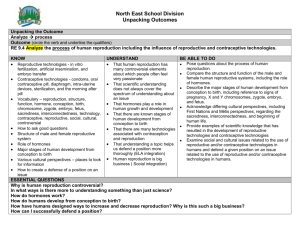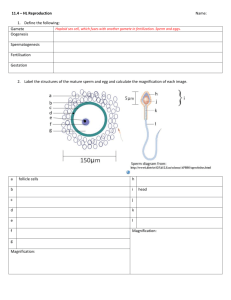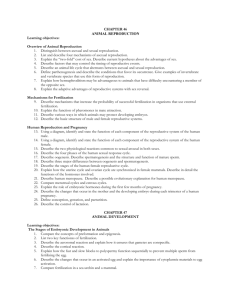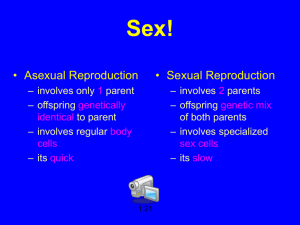IB HL Reproductive System Unit Plan
advertisement
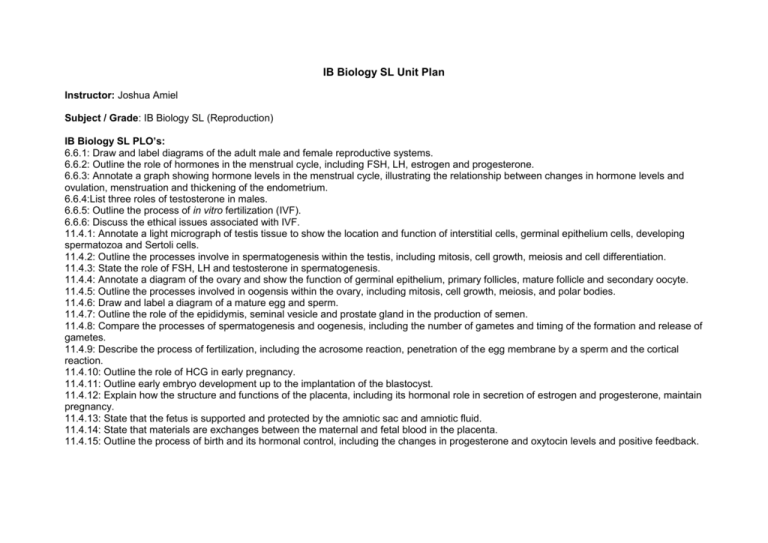
IB Biology SL Unit Plan Instructor: Joshua Amiel Subject / Grade: IB Biology SL (Reproduction) IB Biology SL PLO’s: 6.6.1: Draw and label diagrams of the adult male and female reproductive systems. 6.6.2: Outline the role of hormones in the menstrual cycle, including FSH, LH, estrogen and progesterone. 6.6.3: Annotate a graph showing hormone levels in the menstrual cycle, illustrating the relationship between changes in hormone levels and ovulation, menstruation and thickening of the endometrium. 6.6.4:List three roles of testosterone in males. 6.6.5: Outline the process of in vitro fertilization (IVF). 6.6.6: Discuss the ethical issues associated with IVF. 11.4.1: Annotate a light micrograph of testis tissue to show the location and function of interstitial cells, germinal epithelium cells, developing spermatozoa and Sertoli cells. 11.4.2: Outline the processes involve in spermatogenesis within the testis, including mitosis, cell growth, meiosis and cell differentiation. 11.4.3: State the role of FSH, LH and testosterone in spermatogenesis. 11.4.4: Annotate a diagram of the ovary and show the function of germinal epithelium, primary follicles, mature follicle and secondary oocyte. 11.4.5: Outline the processes involved in oogensis within the ovary, including mitosis, cell growth, meiosis, and polar bodies. 11.4.6: Draw and label a diagram of a mature egg and sperm. 11.4.7: Outline the role of the epididymis, seminal vesicle and prostate gland in the production of semen. 11.4.8: Compare the processes of spermatogenesis and oogenesis, including the number of gametes and timing of the formation and release of gametes. 11.4.9: Describe the process of fertilization, including the acrosome reaction, penetration of the egg membrane by a sperm and the cortical reaction. 11.4.10: Outline the role of HCG in early pregnancy. 11.4.11: Outline early embryo development up to the implantation of the blastocyst. 11.4.12: Explain how the structure and functions of the placenta, including its hormonal role in secretion of estrogen and progesterone, maintain pregnancy. 11.4.13: State that the fetus is supported and protected by the amniotic sac and amniotic fluid. 11.4.14: State that materials are exchanges between the maternal and fetal blood in the placenta. 11.4.15: Outline the process of birth and its hormonal control, including the changes in progesterone and oxytocin levels and positive feedback. Summative Assessment Three quizzes; Unit Test. Resources: IB Biology text (Damon et al.). Date Lesson Topic Subject PLO’s Mar. 23 Ch. 6 Reproduction (Damon et al. 186, 310-311). 6.6.1 Draw and label diagrams of the adult female reproductive system. 11.4.4: Annotate a diagram of the ovary and show the function of germinal epithelium, primary follicles, mature follicle and secondary oocyte. Student Activities Teacher Activities Make name cards. Demonstrate knowledge of reproduction. Jigsaw to complete pp. 1, 3-4 of handout. Step through female reproductive tract as a class (including ovaries and oogenesis). Draw and label the female reproductive tract warm-up activity (peer assessed). Introduce myself. Probe for students knowledge about reproduction (e.g. ploidy, mitosis, meiosis). Provide reproduction hand-out. Step through female reproductive tract. 11.4.5: Outline the processes involved in oogensis within the ovary, including mitosis, cell growth, meiosis, and polar bodies. 11.4.6: Draw and label a diagram of a mature egg and sperm. Mar. 25 Ch. 6 Reproduction (Damon et al. 185, 307-309, 311). 6.6.1 Draw and label diagrams of the adult male reproductive system. Provide quiz answers for peer assessment. Facilitate student-led flow 11.4.1: Annotate a light micrograph of testis tissue to show the location and function of interstitial cells, germinal epithelium cells, developing spermatozoa and Sertoli cells. 11.4.2: Outline the processes involved in spermatogenesis within the testis, including mitosis, cell growth, meiosis and cell differentiation. Work on pages 1, 6-7 of reproduction handout. Create a class flowchart for spermatogenesis to ejaculation. TPS to compare and contrast oogenesis and spermatogenesis. chart for spermtaogenesis to ejaculation. Review the locations and functions of the different parts of the male reproductive tract. Compare and contrast oogenesis and spermatogenesis. 11.4.6: Draw and label a diagram of a mature egg and sperm. 11.4.7: Outline the role of the epididymis, seminal vesicle and prostate gland in the production of semen. Mar. 27 Ch. 6 Reproduction (Damon et al. 186-188). 11.4.8: Compare the processes of spermatogenesis and oogenesis, including the number of gametes and timing of the formation and release of gametes. 6.6.2: Outline the role of hormones in the menstrual cycle, including FSH, LH, estrogen and progesterone. 6.6.3: Annotate a graph showing hormone levels in the Quiz: Male and female reproductive tracts, oogenesis and spermatogenesis. Work on handout p. 2, 5. In groups, create a Proctor quiz. Facilitate the construction of a class flowchart on hormones in female reproduction. Review the roles of FSH, menstrual cycle, illustrating the relationship between changes in hormone levels and ovulation, menstruation and thickening of the endometrium. flowchart to show the effect of hormones in uterine and ovarian cycles (include oogenesis mitosis, meiosis I and II, fertilization). LH, estrogen and progesterone in the uterine and ovarian cycles. Birth control extension and negative feedback control. 6.6.4:List three roles of testosterone in males. 11.4.3: State the role of FSH, LH and testosterone in spermatogenesis. Mar. 31 Ch. 6 Reproduction (Damon et al. 312-314). 11.4.9: Describe the process of fertilization, including the acrosome reaction, penetration of the egg membrane by a sperm and the cortical reaction. 11.4.10: Outline the role of HCG in early pregnancy. Kahoot quiz on female reproductive hormones. Work on handout top of page 8, male reproductive hormones. Work on pages 10-12 of handout. Quiz: Reproductive hormones, fertilization and early pregnancy. Work on pp. 13-14 of handout. Facilitate the Kahoot quiz. Review any questions that are unclear. Review male reproductive hormones. Introduce fertilization and early pregnancy. 11.4.11: Outline early embryo development up to the implantation of the blastocyst. Apr. 2 Ch. 6 Reproduction (Damon et al. 314-317). 11.4.12: Explain how the structure and functions of the placenta, including its hormonal role in secretion of estrogen and progesterone, maintain pregnancy. Proctor quiz. Introduce maternal-fetal exchange. Review maternal-fetal Review exercise for maternal-fetal exchange. 11.4.15: Outline the process of birth and its hormonal control, including the changes in progesterone and oxytocin levels and positive feedback. Review maternal-fetal exchange. Translational activity for process of birth. Presentations 11.4.15: Outline the process of birth and its hormonal control, including the changes in progesterone and oxytocin levels and positive feedback. Complete translational activity presentations. Quiz: Fertilization to birth. Complete p. 8 of handout. IVF debate Reproduction review. 11.4.13: State that the fetus is supported and protected by the amniotic sac and amniotic fluid. exchange. 11.4.14: State that materials are exchanges between the maternal and fetal blood in the placenta. Apr. 8 Apr. 10 Ch. 6 Reproduction (Damon et al. 316-317). Ch. 6 Reproduction (Damon et al. 316-317). Review maternal-fetal exchange. Introduce translational activity for process of birth. Assess translational activity. Assess translational activity. Review fertilization to birth. Proctor quiz. Introduce IVF and debate. 6.6.5: Outline the process of in vitro fertilization (IVF). 6.6.6: Discuss the ethical issues associated with IVF. Apr. 14 Ch. 6 Reproduction (Damon et al. 316-317). Debate and review. Mediate IVF debate. Facilitate reproduction review. Apr. 16 Reproduction test. Reproduction test. Reproduction test. Reproduction test.

